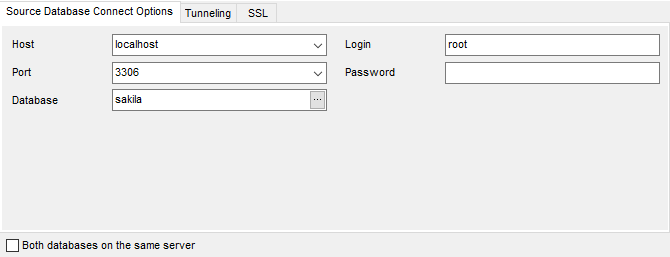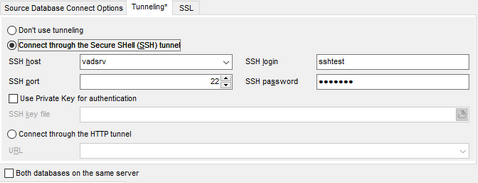Online Documentation for DB Comparer for MySQL
Setting database options
Database connection properties for the source and target databases are set in the same way.
If both the source and target databases are located on the same server, you can check the ![]() Both databases on the same server option and set all the properties (except for the database name) only once.
Both databases on the same server option and set all the properties (except for the database name) only once.

Connect options
First select the connection type: local or remote.
Local connection is used to connect to MySQL server launched on the same machine where DB Comparer for MySQL is running.
The Remote mode allows you to connect to MySQL server launched on another computer in the network.
By default the program uses local connection. It is indicated by switch Local selected. If you wish to set remote connection, you should select the Remote switch. For remote connection you should also enter MySQL host name in the Connection host field. The Connection host drop-down list contains the list of hosts already registered in the program. For both types you should enter MySQL port to connect through in the Connection port field.
Authorization
Afterwards you should specify authorization settings: Login and Password.
The default superuser name is 'root' and the default password is empty.
After that it is necessary to specify the database you are going to work with: type in its name in the Database field or use the ![]() ellipsis button to select one from the Select database list.
ellipsis button to select one from the Select database list.
If necessary, use the drop-down list to specify the preferable Client charset to be used by the application.
If you are using the EMS SQL Management Studio for MySQL version of DB Comparer for MySQL then the Select registered database button is available. Click this button to pick a database already registered in the EMS SQL Management Studio in the Select Host or Database dialog.
Tunneling
To setup the connection via SSH tunnel, input the following values in the corresponding fields:
- SSH host name is the name of the host where SSH server is running
- SSH port indicates the port where SSH server is activated
- SSH user name stands for the user on the machine where SSH server is running (Note: it is a Linux/Windows user, not a user of MySQL server)
- SSH password is the Linux/Windows user password
Note: When the SSH tunneling is set the '*' symbol appears on the tab header.

![]() Use Private Key for authentication
Use Private Key for authentication
Check this option to enable Private Keys usage for the connection.
For details see SSH tunneling options.
To use HTTP tunneling, just upload the tunneling script to the webserver where MySQL server is located, or to any other webserver from which direct connections to your MySQL server are allowed. This script exposes the MySQL API as a set of web-services which are used by DB Comparer for MySQL.
For details see HTTP tunneling options.
SSL
SSL mode
Select the required SSL mode from the dropdown menu: Disabled, Allow, Prefer, Require, Verify CA, Verify Full.

Root certificate
Select the path to the client root.crt file.
Client certificate
Select the path to the client certificate.
Client key
Select the path to the client private key.
Revocation list
Select the file for Certificate Revocation List.
When done, press the Next button to set compare options.


































































